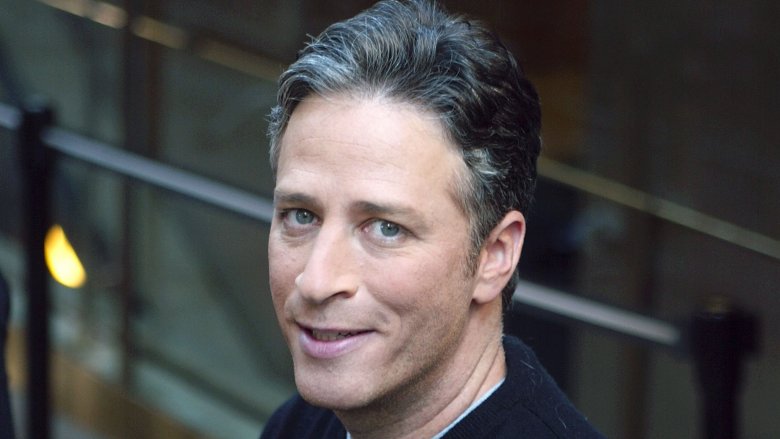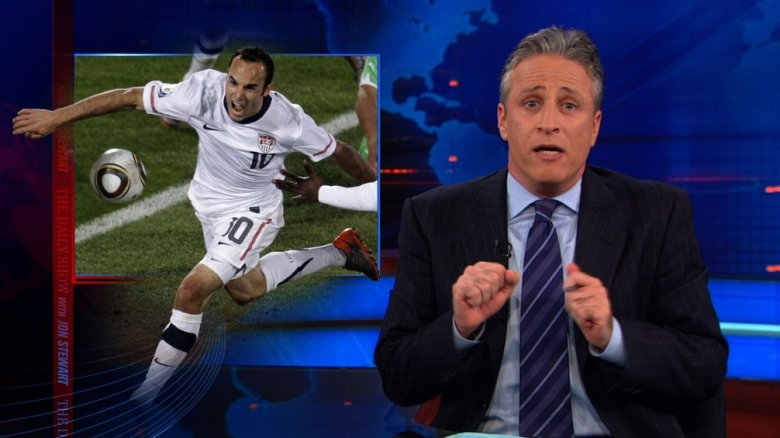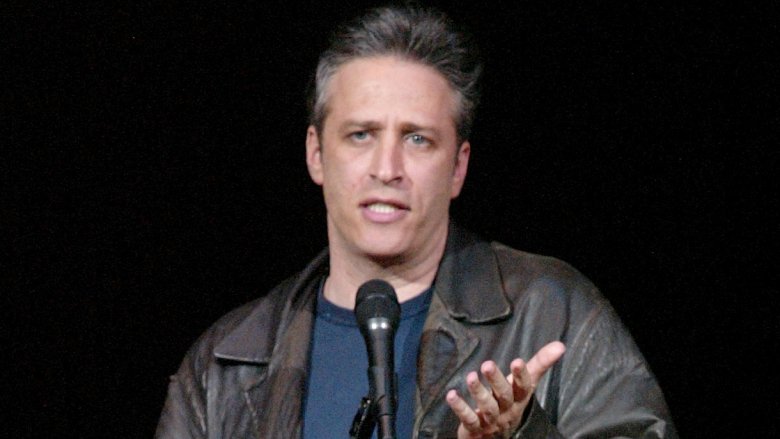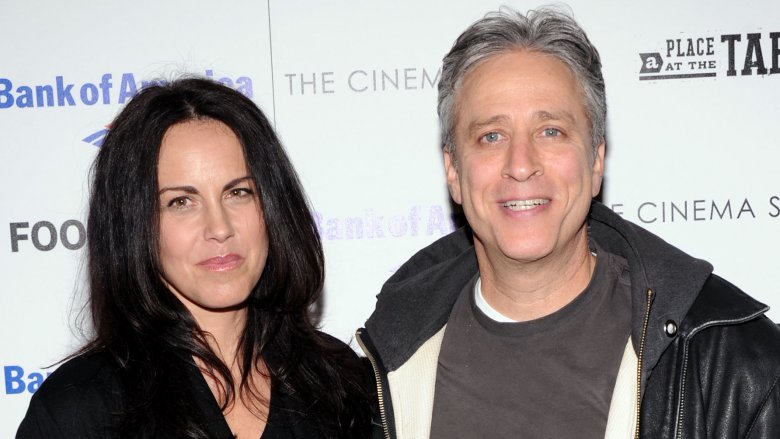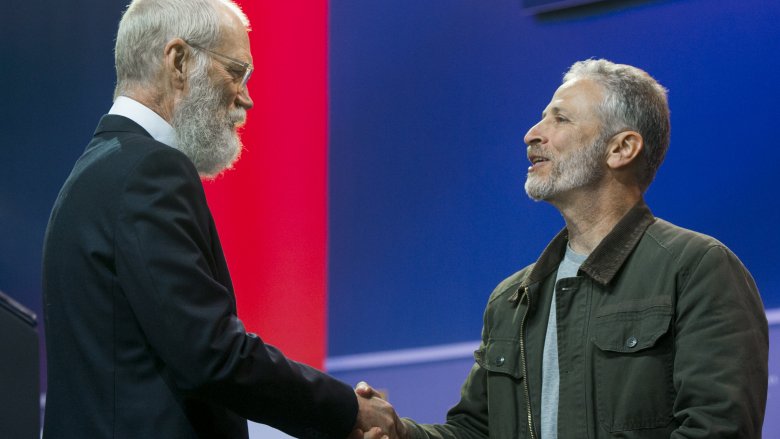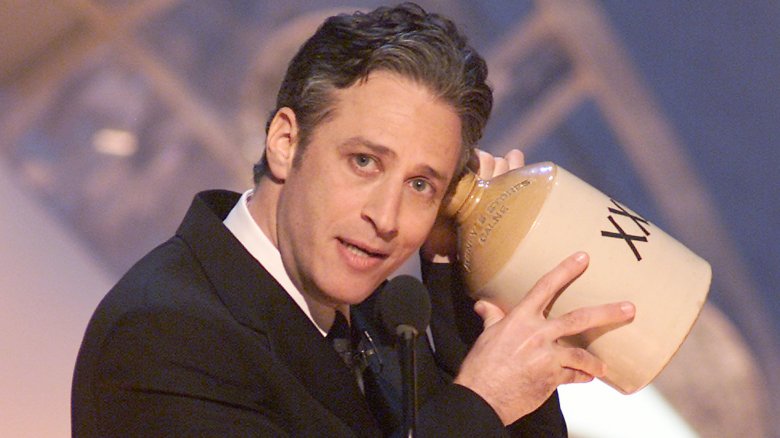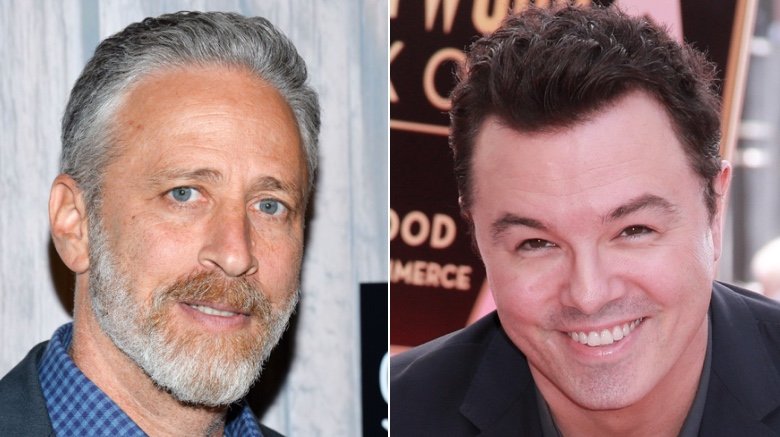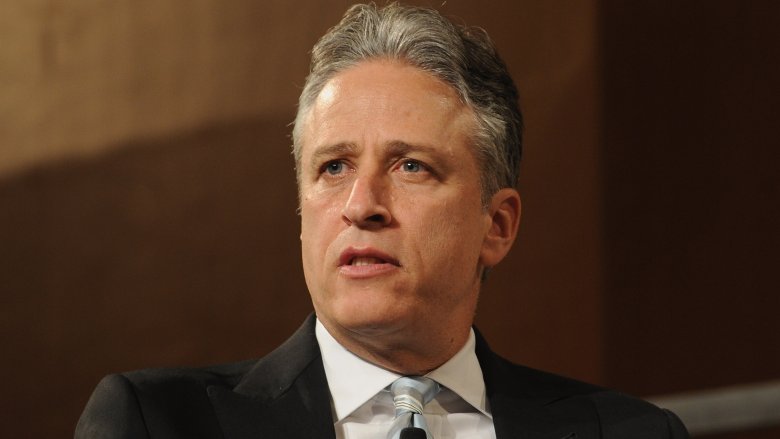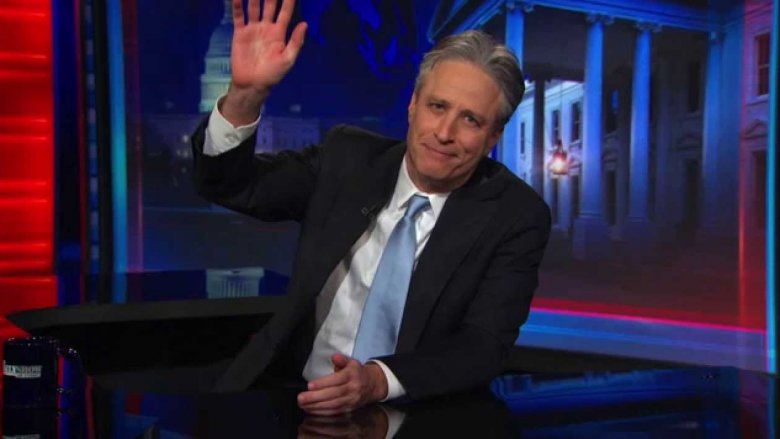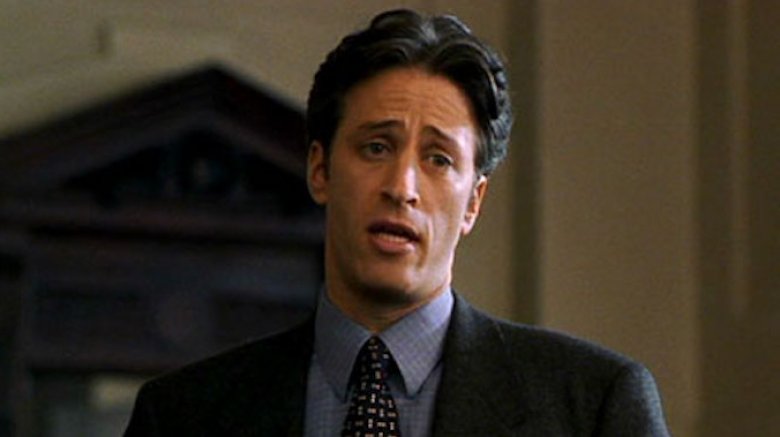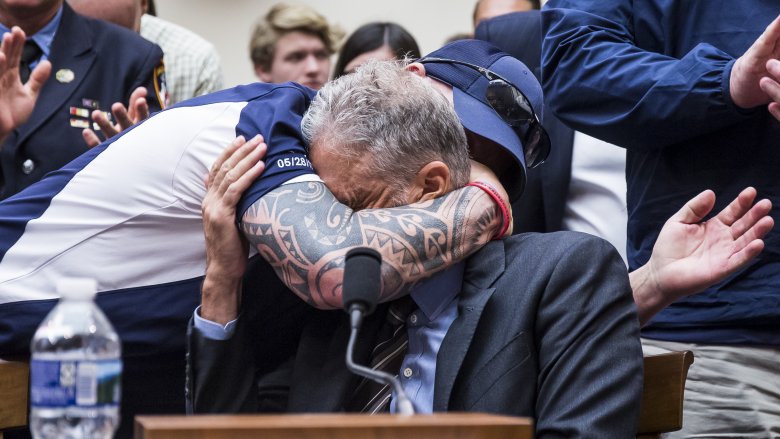The Untold Truth Of Jon Stewart
Jon Stewart came to the attention of the masses in 1993, when he was plucked from the relative obscurity of the stand-up comedy scene and little-watched cable TV gigs to host The Jon Stewart Show, MTV's first night-time talk show. He was a cool late-night host for a new generation. A far cry from Johnny Carson, Stewart interviewed cool rock bands and wore a cool leather jacket. After the show moved to syndication and was canceled, Stewart continued to hone his stand-up act, took on some acting roles, and basically bid his time until his huge second act.
In 1999, Stewart succeeded Craig Kilborn as host of The Daily Show. Under Stewart's guidance, the series evolved from a parody of lightweight news magazines into one of TV's funniest (and at times, most incendiary) satirical forces. Stewart abruptly left The Daily Show in 2015, but the Emmy-winner is still out there, pursuing a range of interests. Here's a look at the untold truth of the world's most famous fake newsman.
Yeah, he can kick it
Not only is Jon Stewart demonstrably funny and intelligent, but he's got some athletic skills, too. He played soccer at Lawrence High School in New Jersey, and when he attended the College of William & Mary in Virginia in 1980, Stewart thought he'd waltz onto the varsity soccer team as a non-recruited freshman. "He probably was [a] little naïve..." William & Mary Coach Al Albert told ESPN. "He probably figured, 'I'm coming in and I'll be on the team and everything.'"
That's accurate, according to Stewart's foreword in Albert's book, William and Mary Men's Soccer. "I walked into his office to deliver the good news that I, an all-state soccer player (honorable mention) from a powerful program in New Jersey (group two, small, but a class above experimental and home schools) had decided to grace the college soccer program with my presence," Stewart wrote. "Coach thanked me for my offer and gently explained the team was well stocked and he would be tracking my progress with their vaunted JV program, which turned out to be not so much a program as a sign-up sheet in a Greek kid's dorm room." Stewart worked hard and, what do you know? He eventually earned a spot on the varsity squad.
He served up many 'Whacks to the Head'
After he graduated from college, Jon Stewart worked from 1984 to 1987 tending bar at City Gardens, a punk rock club in Trenton, N.J., according to the Daily Beast. Stewart saw rock icons up close, including Black Flag, Brad Brains, Joan Jett, X, and Red Hot Chili Peppers. Joey Ramone of the Ramones was reportedly a regular. While Stewart witnessed his share of drunken debauchery and anti-establishment fueled destruction, being around musicians awakened him to the notion of pursuing the arts. "Finding this place City Gardens was like, 'Oh, maybe I'm not a giant weirdo,'" he told Vulture. "'Maybe there are other people who have a similar sense of yearning for something other than what they have now.' I think it inspired a lot of people, man. It was a very creative environment."
City gardens was a creative environment in at least one way. It's where Stewart invented an imposing cocktail called "The Whack in the Head." According to the Daily Beast, that's a mixture of two already potent cocktails — the Alabama Slammer (made with spiced whiskey, sloe gin, and amaretto) and the Long Island Iced Tea (which includes vodka, rum, gin, tequila, and triple sec). Had he never launched a successful comedy career or hosted The Daily Show, inventing that drink might have been Stewart's claim to fame.
He used to be Jon Stuart
Jon Stewart's name may feel so stage-and-TV-ready that it's surprising to learn it's his real name. Well, sort of. His full name is Jon Stuart Leibowitz, so he uses his given first name and a different spelling of his middle name.
According to The Observer (via The Guardian), Stewart's father, physics professor Donald Leibowitz, left the family when Jon was 9 years old. That experience, the subsequent divorce, and its aftermath left Stewart with what he told The Guardian was a "complicated" relationship with dear old dad. It was so strained that when he became a public figure, Jon dropped his father's last name completely. "There was a thought of using my mother's maiden name," he said, "but I thought that would be just too big a f*** you to my dad."
Stewart says the name change has still invited criticism from people who think he made the switch to mask his Jewish background. "People always view it through the prism of ethnic identity," he said. "I hate myself for a lot of reasons, but not because I'm Jewish."
He nearly fumbled the best blind date of his life
Jon Stewart married the former Tracey McShane in 2000, and they have two kids together, a daughter named Maggie and a son named Nathan. Those kids owe their lives to a random crew member on a late '90s project and to their father's sleuthing skills. Stewart and McShane were set up on a blind date, although unlike the usual blind date situation — when a mutual friend sets up the romance — this matchmaker was a total stranger to Stewart.
"I was shooting something in lower Manhattan and a woman that was working on the set said, 'I know this girl who I think you would very much like.' And the way she described her was in such glowing terms, I thought, well, I'd be a jackass not to go out with this woman," Stewart recalled on Larry King Live in 2002. He got her phone number and wrote it down on a dollar bill ... which he then accidentally used to buy cigarettes. Fortunately, the cast sheet from that project had the matchmaking stranger's number on it, and his future wife just so happened to be her roommate.
The Stewarts' road to the altar includes another romantic storyline. With help from The New York Times crossword puzzle editor Will Shortz, Stewart crafted a personalized puzzle for McShane, which, when solved, revealed a marriage proposal.
He almost hosted shows for ABC...and CBS...and NBC
As a prominent and personable comedian in the early 1990s with a well-received show on MTV under his belt, Jon Stewart often made the short-list when a network needed a new host for one its late-night stalwart shows. At various points over 25 years, Stewart came close to hosting a program for all the "big 3" broadcasters.
When David Letterman fled NBC's Late Night for an earlier time slot at CBS, the Peacock Network needed a new host. According to New York (via Vulture), Stewart "made it to the finals of NBC's Replace Dave Sweepstakes" but lost to Conan O'Brien. In 1999, Tom Snyder left his post as host of CBS' post-Letterman program, The Late, Late Show. According to The Washington Post, Stewart's name was bandied about, although Craig Kilborn got the job. That left a vacancy at The Daily Show — a job Stewart would successfully land.
Stewart nearly wound up at CBS a few years later. Entertainment Weekly reported that CBS had considered giving Letterman's slot to Stewart if Letterman accepted ABC's offer to switch networks. Letterman stayed put, so then ABC reportedly went after Stewart instead. According to The New York Times (via The Jon Stewart Resource), ABC aggressively pursued Stewart but ultimately gave its late-night hosting gig to Stewart's Comedy Central colleague, Jimmy Kimmel.
Where's Stewart this week? (Cancelled)
You may not realize that Jon Stewart was the regular host of three TV talk shows. Sure, there's The Jon Stewart Show on MTV and in syndication and The Daily Show on Comedy Central, but in late 1996, Stewart also hosted a show for the BBC2 — that's British broadcast television — called Where's Elvis This Week? Panel shows — where a host goofs around with several guests all at once — are historically and consistently popular in the United Kingdom, and this bizarrely and confusingly titled series was of that ilk.
Stewart held court over a group of four guests (two from the U.S. and two from the U.K.) as they joked about current events and shared cultural perspectives with their counterparts from across the pond. Stewart landed some top-notch guests, including Norm Macdonald, Dave Chappelle, Nora Ephron, and Craig Kilborn (then the host of what was a brand new program called The Daily Show.) Alas, English viewers weren't attracted to Stewart's shtick, and the Elvis show left the building after just five episodes.
Stewart v. MacFarlane
According to The Angry Optimist: The Life and Times of Jon Stewart, by Lisa Rogak, Stewart once took great offense at a Family Guy cutaway joke. According to a staffer on the Fox cartoon who spoke with Pop Focal, the tension went down in a 2008 episode titled "McStroke." In the episode, Peter Griffin has a horse leg, and Brian the dog comes up behind Peter and startles him, prompting the horse leg to deliver a kick to Brian's face. Peter says, "Ah, Brian I'm sorry but what do I keep saying? Do not stand behind me." Why would that be offensive to Stewart?
During the 2007-08 Writers Guild of America strike, The Daily Show stayed on the air, rerunning old material instead of relying on its writers to craft new stuff. Stewart defended the show's decision to soldier on, allegedly saying something about the writers standing behind him. In the aforementioned Family Guy clip, Stewart supposedly understood that the incredibly subtle horse leg joke was a dig directed his way. Rogak claims Stewart called up Family Guy creator Seth MacFarlane "and proceeded to scream and yell at him for a full hour, saying he had no right to call him out on that." According to MacFarlane, Stewart said something along the lines of: "Who the hell made you the moral arbiter of Hollywood?"
McFarlane and Stewart have apparently patched things up, at least for the sake of business, because the latter appeared on The Daily Show in 2012 to promote Ted.
He improved health care for military veterans
The Daily Show is a satirical program. At its best, it aims to speak truth to power and mobilize the masses by making fun of and pointing out the ways that powerful systems and people fail the "little guy." On at least one occasion while Jon Stewart held the reins, the show also brought about a significant change in governmental policy that helped a lot of military veterans.
The U.S. Department of Veterans Affairs created the Veterans Choice Program to allow veterans who don't live near a VA hospital get the care they need at an "out of network" facility. To qualify, a veteran had to live at least 40 miles from an in-network VA institution, but as Stewart explained in a Daily Show segment, that 40 miles was calculated "as-the-crow-flies" rather than by the mileage it took for "non-crows" to actually travel to an appropriate health care location.
That Daily Show piece aired on March 23, 2015. The next day, the Department of Veterans Affairs changed the rule to a practical system of measurement. As a result, the number of veterans able to use the Choice Program reportedly doubled, literally overnight, reported The Huffington Post.
The Daily Show became the daily grind
Jon Stewart became an elder statesman of late-night television, providing both the news and a therapeutic way to process the nerve-wracking events that make up the news to millions of viewers four nights a week. Fans of the The Daily Show were most certainly looking forward to Stewart's coverage of the upcoming 2016 presidential election, but the host shocked audiences when he announced in February 2015 that in a few months time, he'd be leaving the show. "I don't have any specific plans..." he quipped at the end of that very special episode. "I'm gonna have dinner on a school night with my family, who I have heard from multiple sources are lovely people."
At The Daily Show LIVE event in 2018 (via The Huffington Post), Stewart's successor, Trevor Noah, offered insight about why Stewart left the high-profile job. Noah said covering the world's ills for 16 years had left Stewart emotionally drained. "He said 'I'm leaving because I'm tired.' And he said, 'I'm tired of being angry.' And he said, 'I'm angry all the time. I don't find any of this funny. I do not know how to make it funny right now ... I don't think the show deserves a host who does not feel that it is funny."
Big on the small screen, small on the big screen
Apparently, the universe won't allow a person to be both a major late-night talk show host and a movie star. Jimmy Fallon's pre-Tonight Show film career consists of misses such as Fever Pitch and Taxi, while Jay Leno starred in the 1989 buddy cop dud Collision Course with Pat Morita. Seeing his name in lights on a movie theater marquee just wasn't in the cards for Jon Stewart either. He gave acting a try, but his endeavor didn't advance beyond supporting roles and bit parts.
After the cancellation of The Jon Stewart Show, but before he took over The Daily Show, Stewart appeared on episodes of NewsRadio and The Nanny, landed a cameo as a guy who thinks everything is better "on weed" in Half Baked, and showed up in the horror movie The Faculty and in the ensemble romantic comedy Playing by Heart. A role as the younger lover of Goldie Hawn's character in The First Wives Club might have been a breakout role for Stewart ... if only all of his scenes hadn't been cut. Nearly 20 years later, Stewart was actually offered a part in an obscure sci-fi lark called Star Wars: The Force Awakens. According to Empire Online, he could have played a (masked) Stormtrooper, but he turned down the part because he didn't want to portray a villain.
He tearfully testified to Congress
Even though he no longer has a nationally televised platform, Jon Stewart still calls out injustice when he sees fit. In 2010, Congress debated the James Zadroga Health and Compensation Act, which included the 9/11 Victim Compensation Fund. According to CBS News, that fund provides financial aid for serious medical issues to emergency workers who responded to the terrorist attacks on the World Trade Center in 2001. Stewart addressed the issue on The Daily Show, and he's since become an advocate for members of that group, which have been beset by health problems — including more than "11,000 types of cancer."
One problem with the Victim Compensation Fund: Congress only authorized funding through the end of 2020. In June 2019, Stewart joined some 9/11 responders to urge reauthorization, testifying before the House Judiciary Subcommittee on Civil Rights and Civil Liberties. Only about half of the committee's members reportedly showed up, which incensed Stewart. "I can't help but think what an incredible metaphor this room is," he said. "Behind me, a filled room of 9/11 first responders, and in front of me, a nearly empty Congress. Sick and dying, they brought themselves down here to speak to no one." He spoke through tears and anger, and received a standing ovation from observers.
The next day, the subcommittee unanimously approved a bill to continue funding the 9/11 Victim Compensation Fund. At the time of this writing, that legislation was making its way through the system on Capitol Hill.

